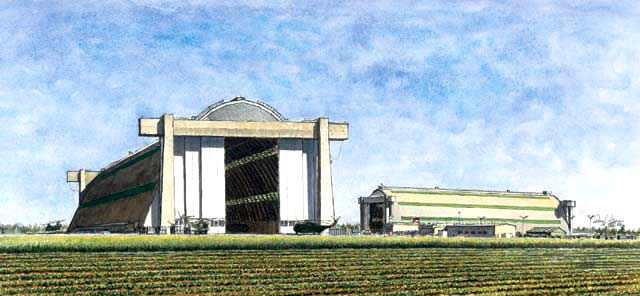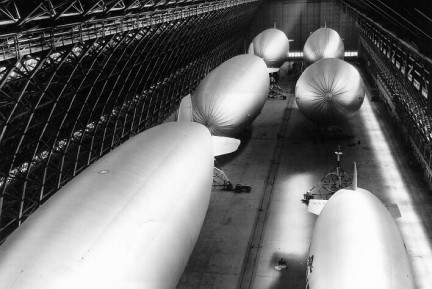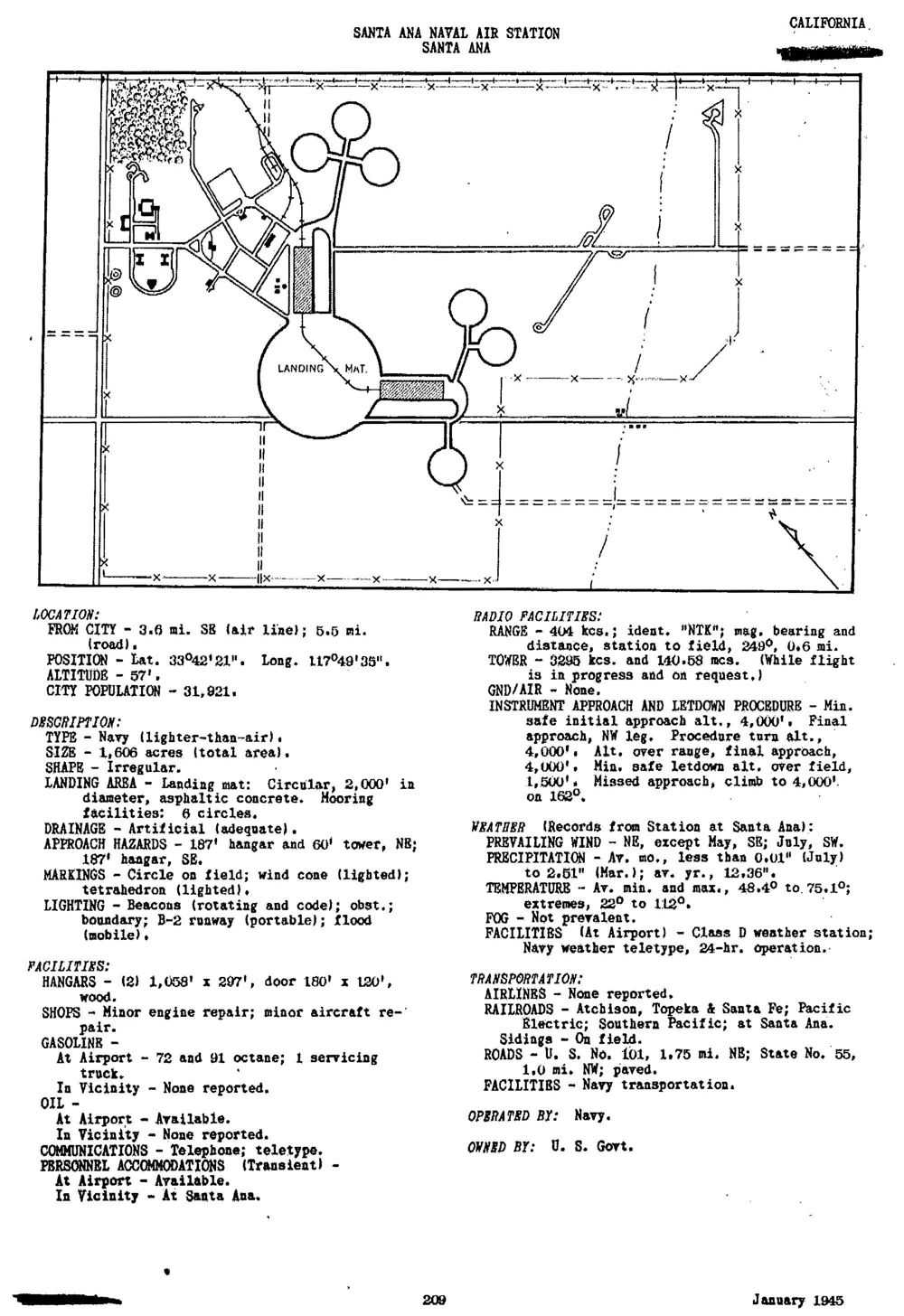

This field was originally built as a blimp base in 1942 as Santa Ana Naval Air Station. The predominant characteristic of this field is the image of its two huge blimp hangars. It was commissioned in October of that year as one of two new blimp bases on the west coast. The other was at Tillamook, Oregon. Blimps were used to patrol America's coastline primarily to watch for enemy submarine. At first 6, then 12 blimps operated out of the station. The large, all-wood hangers were built to house the blimps and at the time of their construction were and still are the world's largest clear span wooden buildings. These hangers became a necessity when the strong Santa Ana winds blew in from the desert disrupting blimp operations. The station had 6 mooring circles and its own helium generating plant.After the war the station was reduced in status as blimp operations were phased out.
The hangars are each more than 1,000 feet long & 300 feet wide. Each hangar was designed to hold six blimps simultaneously (see below) . In between the two hangars is a huge concrete circular blimp mooring pad. Extending outward from the central pad are concrete taxiways leading to numerous smaller concrete circular blimp mooring pads.
Following the end of World War II, the Santa Ana NAS was decommissioned by the Navy in 1949. It was then transferred to the Marine Corps in 1951, and was renamed Marine Corps Air Facility Santa Ana by 1965. It was later renamed Marine Corps Air Station Tustin.
The Marines used Tustin as their primary West Coast helicopter base, operating Medium & Heavy Transport & Attack Helicopter squadrons. A small 3,000 foot runway was built in between the "V" formed by the two blimp hangars (which must have made for interesting turbulence during crosswinds), along with a control tower nestled in between. Two modern hangars were added on the edge of the blimp mooring pad for helicopter maintenance.
The unique facilities at Tustin were very well suited to large-scale helicopter operations, as the blimp hangars were capable of providing indoor storage for huge numbers of helicopters, & the blimp mooring pad provided acres of ramp space for parking. At its peak, Tustin housed over 100 helicopters.
Tustin's location also was very suitable for USMC helicopter operations, as the surrounding mountain ranges included a total of 13 Confined Area Landing Sites,at elevations ranging from 1,000 to 5,000 feet above sea level.
Due to Tustin's proximity to Hollywood & the unique imagery of the blimp hangars, it has been used for location shooting for numerous movies & TV programs, including JAG, The X-Files, etc.
Following Tustin's closure by the Marine Corps in 1999, one of the blimp hangars has been designated a national historic landmark, and is to be preserved (the second one presumably will be torn down). Overall, plans were approved by the local government to reuse the property for a mixture of purposes, including parkland & commercial development.
Extracted from
Abandoned
and Little Known Airfields

The Navy's Lighter-than-Air master plan called for three blimp
bases on the West Coast -- one north of the existing Moffett and
one to the south. Congress appropriated funds for the stations
in July 1941. In southern California's rural Orange County, a
1,606 acre site was chosen 35 miles southeast of Los Angeles and
10 miles inland. Modeled on South Weymouth and Weeksville, construction
began in April 1942, three and a half miles southeast of the town
of Santa Ana. The property had been cultivated for years so little
was required to prepare it for construction.
Although the hangars had not been completed, the station and ZP-31 commissioned on October 7, 1942, only six months after ground breaking. On October 19, L-8 of Moffett's ZP-32 became the first blimp to land. Incidentally, L-8 had previously distinguished itself as the infamous "Ghost Ship" (see Treasure Island). ZP-31 received its first blimp on November 11, with the arrival of K-20, the first ship assembled on the West Coast (see Moffett). On November 28, 1942, an Army P-38 from the nearby Orange County Airport crashed into a concrete door pylon of an unfinished hangar, killing the pilot.
The building of two wooden blimp hangars was aided by a movable scaffold, mounted on 18 railroad flatcars. The location was considerably less than ideal for blimp operations, since the area was subject to strong desert winds, coincidentally known as "Santa Anas." Twice during construction, erected hangar trusses were felled. On January 23, 1943, an 85-mph gust of wind blew down a truss. Two weeks later, another gust moved the scaffold train pulling down three more trusses.
In 1943, Santa Ana realized the need for two auxiliary facilities. In May 1943, the station sent 14 men to establish an auxiliary at Lompoc, California, 140 miles northwest of Los Angeles near Pt. Auguello. One month later, a similar complement was sent to Del Mar, another auxiliary just north of San Diego. On August 16, 1943, VJ-8 with nine officers and 66 enlisted men arrived at Santa Ana establishing a target drone school. The next month a detachment of Blimp Headquarters Squadron Three formed to support ZP-31.
The year of 1944 was somewhat uneventful. VJ-11 replaced VJ-8, and by September had a complement of 14 officers and 148 men. At this time, VJ-11 operated one JRF, 2 SNBs, one SNJ, eight TDC drones, 11 TD2C drones, and 70 S03Cs. Due to the unsatisfactory performance of the S03C Curtiss Seamew, the Navy converted many into radio-controlled drones, finding a use for the aircraft.
On May 5, 1945, K-51 experienced an in-flight fire that killed eight of the nine-man crew. K-51 had dumped fuel in preparation for landing and inadvertently descended into the gasoline vapor subsequently ignited by the engines. MCAS El Toro is only seven miles southeast of Santa Ana and in June, a Marine fighter replacement squadron, VMF-462, was on board the station with 21 Corsairs. Also in June, ZP-31 received its first new "M" ships. During the war, Metro-Goldwyn-Mayer used the sta tion to make two motion pictures -- a Navy training film and the commercial production This Man's Navy. In September, Lompoc and Del Mar closed.
Santa Ana initially cost $11 million to build. One half of that cost went for the two 1000-ft. wooden blimp hangars. The airfield amounted to a 2,000-ft. diameter circle asphalt landing mat with six-mooring circles. Although the base originally had billeting for a total of 456 men, by March 1944, barracks had grown to accommodate 152 officers and 1242 enlist ed men. The maximum number of blimps present reached 14 K and L ships. The station usually operated one GB Staggerwing for transport.
Following the war, all blimp squadrons decommissioned except two which included Santa Ana's ZP 31 renamed ZP-1. Santa Ana also became an aircraft storage facility in November 1945. Finally in August 1947, the Navy relocated ZP-1 to Weeksville, N. C. and all blimp operations on the West Coast ended. On June 6, 1949, Santa Ana decommissioned becoming an OLF. For a time, the hangars were used by advertising blimps.
The station reopened during the Korean War. Blimp operations staged a brief resurrection when the Navy established a two-blimp Naval Air Reserve Training Unit (NARTU) on April 1, 1951. The Marines arrived the next month establishing a helicopter air facility. West Coast blimp operations ended for good in June 1956, when the Navy disestablished the NARTU. In 1969, the Marines elevated Santa Ana to an MCAS only to change the name to Tustin the next year. In 1975, Malcolm Forbes used a hangar for his attempted balloon flight to Europe. The same year, Universal Pictures used the station for the filming of The Hindenburg.
The 1993 Defense Base Realignment and Closure Commission has recommended the closure of Tustin and El Toro. Both stations, in the country when built 50 years ago, are today surrounded by the urban growth of Orange County. Tustin and El Toro are scheduled for relocating to Miramar and other stations during 1997. The two blimp hangars are still in existence, but reportedly in need of repairs that is estimated to cost $10 million initially, plus a continuing annual maintenance expenditure of $500,000. Although designated as National Historic Landmarks, the hangars razing is also being consid ered -- at a cost of $5 million.
Additional Online Histories
- MCAS (H) Tustin
- NAS Santa Ana
Extract, US Army Air Forces Directory of Airfields
